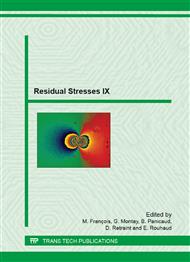[1]
J.A. James, J.R. Santisteban, L. Edwards and M.R. Daymond, 2004. A Virtual Laboratory for Neutron and Synchrotron Strain Scanning. Physica B: Condensed Matter, 350(1-3), pp. E743–E746.
DOI: 10.1016/j.physb.2004.03.194
Google Scholar
[2]
K. Nielsen, K. Lefmann, Monte Carlo simulations of neutron-scattering instruments using McStas, Physica B: Condensed Matter, Volume 283, Issue 4, 3 June 2000, Pages 426-432, ISSN 0921-4526, DOI: 10. 1016/S0921-4526(00)00381-1.
DOI: 10.1016/s0921-4526(00)00381-1
Google Scholar
[3]
G. Zsigmond, K. Lieutenant, S. Manoshin, H. N. Bordallo, J. D. M. Champion, J. Peters, et al., A survey of simulations of complex neutronic systems by VITESS, Nuclear Instruments and Methods in Physics Research Section A: Accelerators, Spectrometers, Detectors and Associated Equipment, Volume 529, Issues 1-3, Proceedings of the Joint Meeting of the International Conference on Neutron Optics (NOP2004) and the Third International Workshop on Position-Sensitive Neutron Detectors (PSND2004), 21 August 2004, Pages 218-222, ISSN 0168-9002, DOI: 10. 1016/j. nima. 2004. 04. 205.
DOI: 10.1016/j.nima.2004.04.205
Google Scholar
[4]
J. Saroun, J. Kulda, RESTRAX - a program for TAS resolution calculation and scan profile simulation, Physica B: Condensed Matter, Volumes 234-236, Proceedings of the First European Conference on Neutron Scattering, 2 June 1997, Pages 1102-1104, ISSN 0921-4526, DOI: 10. 1016/S0921-4526(97)00037-9.
DOI: 10.1016/s0921-4526(97)00037-9
Google Scholar
[5]
BOIN, M., et al., Validation of Bragg edge experiments by Monte Carlo simulations for quantitative texture analysis, Journal of Applied Crystallography, 44 (2011) pp.1040-1046.
DOI: 10.1107/s0021889811025970
Google Scholar
[6]
H.D. Hibbitt, ABAQUS/EPGEN-A general purpose finite element code with emphasis on nonlinear applications, Nuclear Engineering and Design, Volume 77, Issue 3, 2 February 1984, Pages 271-297, ISSN 0029-5493, DOI: 10. 1016/0029-5493(84)90106-7.
DOI: 10.1016/0029-5493(84)90106-7
Google Scholar
[7]
Stefan Reh, Jean-Daniel Beley, Siddhartha Mukherjee, Eng Hui Khor, Probabilistic finite element analysis using ANSYS, Structural Safety, Volume 28, Issues 1-2, Structural Reliability Software, January-April 2006, Pages 17-43, ISSN 0167-4730, DOI: 10. 1016/j. strusafe. 2005. 03. 010.
DOI: 10.1016/j.strusafe.2005.03.010
Google Scholar
[8]
http: /www. nexusformat. org.
Google Scholar


